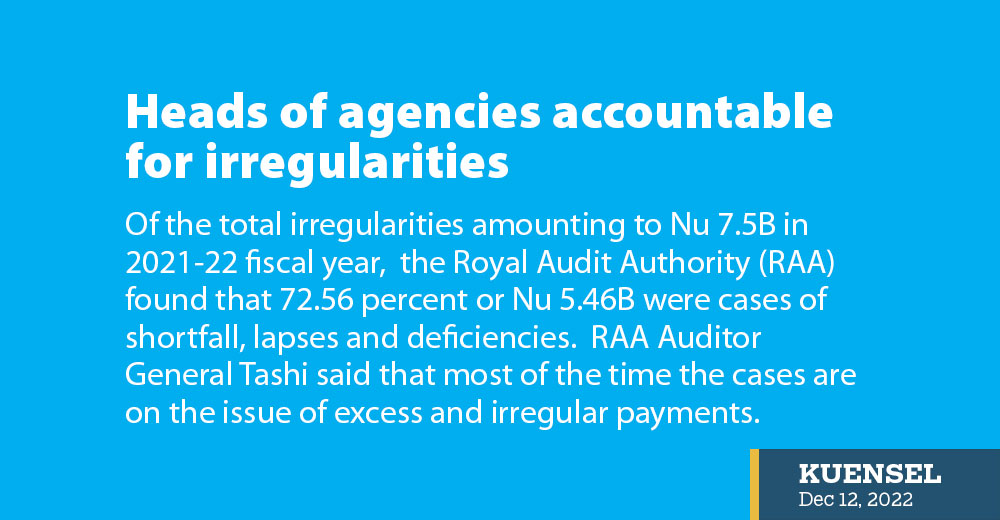Dechen Dolkar
Of the total irregularities amounting to Nu 7.5B in 2021-22 fiscal year, the Royal Audit Authority (RAA) found that 72.56 percent or Nu 5.46B were cases of shortfall, lapses and deficiencies.
RAA Auditor General Tashi said that most of the time the cases are on the issue of excess and irregular payments.
According to the RAA report, most of the excess and irregular payments are made on construction of roads and other construction-related works mostly at the local government level and Department of Roads.
“It may be a collusion between the parties on the excess payment. However, it is very difficult to furnish the evidence,” said the Auditor General.
He said that for instance in the construction of the road the payments are made for six kilometers and when auditors visited the site, it was only three kilometres. “And they claim that it was a mistake.”
He said that it may be possible to have differences of a few meters measurement but the major differences are a kind of collusion. “Now agencies will be asked to take action against site engineers to make them accountable,” said the Auditor General.
He said that in some cases the contractors will also be asked to re-do the work. RAA will not issue the audit clearance for their license renewal if the contractors have not enforced the audit issues.
He said civil servants, who are accountable, will receive disciplinary actions as per the civil service rules and regulations ranging from withholding the increment to termination depending on the severity of the offence.
Regional Revenue and Customs Office (RRCO), Phuentsholing had the highest amount of irregularities on the shortfall, lapses and deficiency amounting to Nu 2.8B followed by Punatsangchhu-I Hydroelectric Project Authority with Nu 696.704M.
According to the RAA report, Phuentsholing RRCO had several instances of information discrepancies in the collection of taxes, fines and penalties on income generated from various sources.
The RAA found that there was a difference in information maintained with the RRCO and the information in the Bhutan Automated Customs System (BACS).
The annual audit report states that RRCO had failed to include information maintained in the BACS to ascertain the taxes, fines and penalties. Since the audit was conducted during the Covid-19 pandemic period and related lockdowns, the RAA is currently conducting a thorough review of the related issues to ensure that the information discrepancies have not led to evasion of taxes, fines and penalties.
The report states that PHPA-I had not recovered an amount of Nu 625.87M from M/s Larsen & Toubro Limited under Contract Package MC-1.
The PHPA-I had made an excess payment of Nu 12.44M to M/s Larsen & Toubro Limited for non-usage of OPC cement in the construction of Shotcrete (PFRS/SFRS) in dam, intake structure and diversion tunnel.
The regional office, DoR Trongsa had made excess payments of Nu 2.676M for the contract works of the Northern East-West highway.
The report also pointed out that the utilisation of monthly and quarterly capital expenditure for three consecutive financial years of 2019-20 to 2021-22 revealed a rush of capital expenditure towards the last quarter of the financial year. It showed 54.95 percent compared to previous quarters which represents only 8.99 percent, 17 percent and 19.05 percent for the first, second and third quarters respectively.
The Auditor General said that it was observed that agencies implementing activities and spending in the last quarter of the financial year led to making unwanted expenditures. “The agencies should plan everything beforehand to avoid such cases.”
The Auditor General also mentioned that irregularities will increase as compared to previous years for two to three years from now because RAA will rigorously audit.


